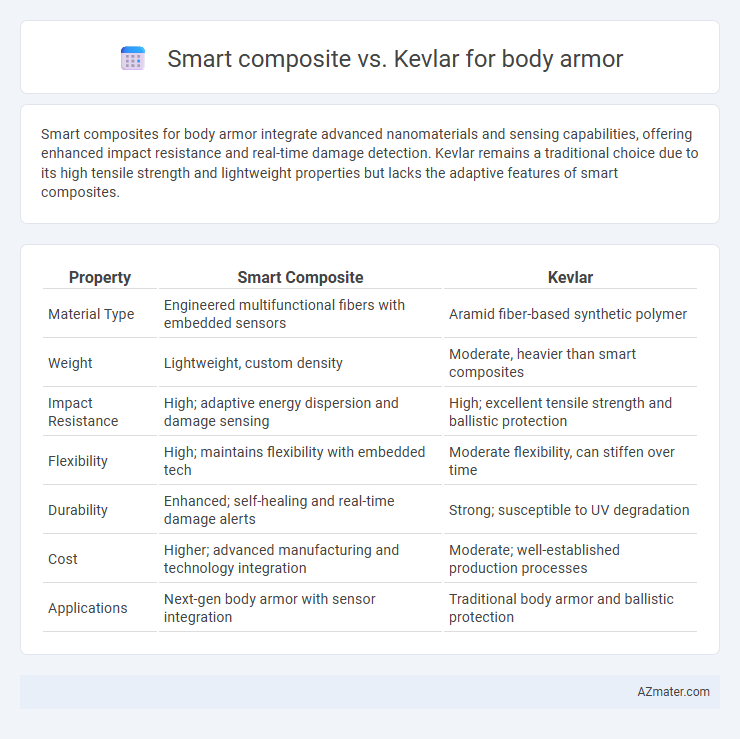Smart composites for body armor integrate advanced nanomaterials and sensing capabilities, offering enhanced impact resistance and real-time damage detection. Kevlar remains a traditional choice due to its high tensile strength and lightweight properties but lacks the adaptive features of smart composites.
Table of Comparison
| Property | Smart Composite | Kevlar |
|---|---|---|
| Material Type | Engineered multifunctional fibers with embedded sensors | Aramid fiber-based synthetic polymer |
| Weight | Lightweight, custom density | Moderate, heavier than smart composites |
| Impact Resistance | High; adaptive energy dispersion and damage sensing | High; excellent tensile strength and ballistic protection |
| Flexibility | High; maintains flexibility with embedded tech | Moderate flexibility, can stiffen over time |
| Durability | Enhanced; self-healing and real-time damage alerts | Strong; susceptible to UV degradation |
| Cost | Higher; advanced manufacturing and technology integration | Moderate; well-established production processes |
| Applications | Next-gen body armor with sensor integration | Traditional body armor and ballistic protection |
Introduction to Body Armor Materials
Smart composite materials for body armor integrate advanced fibers like ultra-high-molecular-weight polyethylene (UHMWPE) and tailored resin systems to enhance impact resistance and flexibility. Kevlar, a para-aramid synthetic fiber, offers exceptional tensile strength and energy absorption, making it a widely used traditional choice in ballistic protection. Comparing these materials involves evaluating factors such as weight, durability, and multi-threat performance to determine the optimal balance for specific body armor applications.
What is Kevlar?
Kevlar is a high-strength synthetic fiber widely used in body armor for its exceptional tensile strength-to-weight ratio and resistance to ballistic impacts. Engineered through a process of spinning aromatic polyamide fibers, Kevlar forms tightly woven layers that absorb and disperse the energy of bullets and shrapnel effectively. Its lightweight and durable properties make it a benchmark material in personal protective equipment, often compared to newer smart composite materials for enhanced flexibility and multi-threat protection.
Overview of Smart Composite Materials
Smart composite materials in body armor integrate advanced fibers and sensors that enhance impact resistance and adaptability compared to traditional Kevlar. These composites often incorporate shape-memory alloys, nanomaterials, and responsive polymers that provide superior energy absorption and real-time damage detection. Their multifunctional properties enable lighter, more flexible armor with improved durability and user comfort.
Comparative Strength and Protection Levels
Smart composites in body armor integrate advanced materials like carbon nanotubes and graphene, offering superior tensile strength and enhanced energy absorption compared to traditional Kevlar. Kevlar provides reliable ballistic protection with high impact resistance but tends to be heavier and less flexible under extreme conditions. The innovative structure of smart composites facilitates better multi-hit performance and reduced blunt force trauma, making them increasingly preferred in modern protective gear technology.
Weight and Flexibility Differences
Smart composites in body armor offer significantly reduced weight compared to Kevlar, enhancing overall mobility for the wearer. These advanced materials provide superior flexibility due to their engineered fiber matrix and resin systems, allowing better contouring and comfort. Kevlar, while strong and impact-resistant, tends to be heavier and less flexible, potentially restricting movement in high-intensity situations.
Durability and Environmental Resistance
Smart composites in body armor utilize advanced materials such as carbon nanotubes and polymers, offering superior durability with enhanced impact absorption and resistance to wear compared to traditional Kevlar fibers. Kevlar provides excellent tensile strength but can degrade when exposed to UV light, moisture, and extreme temperatures, reducing its lifespan in harsh environments. Smart composites demonstrate improved environmental resistance by maintaining structural integrity under prolonged exposure to moisture, heat, and chemical agents, making them more reliable for long-term use in varied operational conditions.
Cost Implications and Availability
Smart composites for body armor often incur higher initial costs due to advanced manufacturing processes and integrated material technologies, while Kevlar remains more cost-effective with widespread commercial availability and established supply chains. Kevlar's mass production and long-standing market presence ensure lower material and replacement expenses compared to the relatively niche and specialized smart composite materials. Budget considerations typically favor Kevlar for large-scale deployment, though smart composites may offer cost benefits in specialized, performance-critical applications where their enhanced properties justify the premium.
Comfort and Wearability for Users
Smart composites used in body armor offer superior comfort and wearability compared to traditional Kevlar due to their lightweight structure and enhanced flexibility. Unlike Kevlar, which can be stiff and bulky, smart composites conform better to the user's body, reducing fatigue during prolonged use. This improved ergonomic design supports greater mobility and comfort without compromising protective performance.
Advanced Features: Smart Composites vs. Traditional Kevlar
Smart composites in body armor integrate sensors and adaptive materials to enhance impact resistance and provide real-time injury detection, surpassing traditional Kevlar's passive protection. These composites offer improved flexibility and lighter weight, contributing to greater wearer mobility and comfort during extended use. Kevlar remains valued for its proven ballistic resistance and durability, but smart composites represent a significant evolution through embedded technology and multifunctional defense capabilities.
Future Trends in Body Armor Technology
Smart composites in body armor integrate sensors and adaptive materials to enhance impact resistance and flexibility, surpassing the traditional ballistic protection offered by Kevlar. Emerging technologies such as nanomaterial-infused smart composites enable real-time damage detection and dynamic stiffness adjustments, optimizing wearer safety and comfort. Future trends emphasize multifunctional armor systems combining lightweight smart composites with Kevlar to maximize protection against diverse threats while reducing weight.

Infographic: Smart composite vs Kevlar for Body armor
 azmater.com
azmater.com